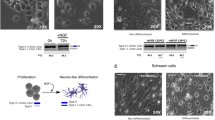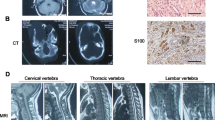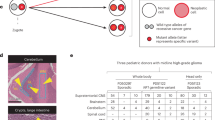Abstract
Neurofibromatosis type 2 (NF2) is an autosomal-dominant disorder affecting about 1:33 000 newborns, mainly characterized by the development of tumors of the nervous system and ocular abnormalities. Around 85% of germline NF2 mutations are point mutations. Among them, ∼25% affect splicing and are associated with a variable disease severity. In the context of our NF2 Multidisciplinary Clinics, we have identified a patient fulfilling clinical criteria for the disease and exhibiting a severe phenotype. The patient carries a deep intronic mutation (g. 74409T>A, NG_009057.1) that produces the insertion of a cryptic exon of 167pb in the mature mRNA between exons 13 and 14, resulting in a truncated merlin protein (p.Pro482Profs*39). A mutation-specific antisense phosphorodiamidate morpholino oligomer was designed and used in vitro to effectively restore normal NF2 splicing in patient-derived primary fibroblasts. In addition, merlin protein levels were greatly recovered after morpholino treatment, decreasing patient's fibroblasts in vitro proliferation capacity and restoring cytoeskeleton organization. To our knowledge, this is the first NF2 case caused by a deep intronic mutation in which an in vitro antisense therapeutic approximation has been tested. These results open the possibility of using this approach in vivo for this type of mutation causing NF2.
Similar content being viewed by others
Log in or create a free account to read this content
Gain free access to this article, as well as selected content from this journal and more on nature.com
or
References
Evans D : Neurofibromatosis type 2 (NF2): a clinical and molecular review. Orphanet J Rare Dis 2009; 19: 16.
McClatchey AI, Giovannini M : Membrane organization and tumorigenesis—the NF2 tumor suppressor, Merlin. Genes Dev 2005; 19: 2265–2277.
Trofatter JA, MacCollin MM, Rutter JL et al: A novel moesin-, ezrin-, radixin-like gene is a candidate for the neurofibromatosis 2 tumor suppressor. Cell 1993; 72: 791–800.
Asthagiri AR, Parry DM, Butman JA et al: Neurofibromatosis type 2. Lancet 2009; 373: 1974–1986.
Evans DGR, Wallace AJ, Wu CL, Trueman L, Ramsden RT, Strachan T : Somatic mosaicism: a common cause of classic disease in tumor-prone syndromes? Lessons from type 2 Neurofibromatosis. Am J Human Genet 1998; 63: 727–736.
Kluwe L, Mautner V, Heinrich B et al: Molecular study of frequency of mosaicism in neurofibromatosis 2 patients with bilateral vestibular schwannomas. J Med Genet 2003; 40: 109–114.
Evans DG, Raymond FL, Barwell JG, Halliday D : Genetic testing and screening of individuals at risk of NF2. Clin Genet 2011; 82: 416–424.
Ahronowitz I, Xin W, Kiely R, Sims K, MacCollin M, Nunes FP : Mutational spectrum of the NF2 gene: a meta-analysis of 12 years of research and diagnostic laboratory findings. Hum Mutat 2007; 28: 1–12.
Baser ME : The distribution of constitutional and somatic mutations in the neurofibromatosis 2 gene. Hum Mutat 2006; 27: 297–306.
Ellis JR, Heinrich B, Mautner VF, Kluwe L : Effects of splicing mutations on NF2-transcripts: transcript analysis and information theoretic predictions. Genes Chromosomes Cancer 2011; 50: 571–584.
Kluwe L, MacCollin M, Tatagiba M et al: Phenotypic variability associated with 14 splice-site mutations in the NF2 gene. Am J Med Genet 1998; 77: 228–233.
Merel P, Hoang-Xuan K, Sanson M et al: Screening for germ-line mutations in the NF2 gene. Genes Chromosomes Cancer 1995; 12: 117–127.
Selvanathan SK, Shenton A, Ferner R et al: Further genotype--phenotype correlations in neurofibromatosis 2. Clin Genet 2010; 77: 163–170.
Cooper DN, Chen J-M, Ball EV et al: Genes, mutations, and human inherited disease at the dawn of the age of personalized genomics. Hum Mutat 2010; 31: 631–655.
De Klein A, Riegman PHJ, Bijlsma EK et al: A G→A transition creates a branch point sequence and activation of a cryptic exon, resulting in the hereditary disorder Neurofibromatosis 2. Hum Mol Genet 1998; 7: 393–398.
Aartsma-Rus A, den Dunnen JT, van Ommen GJ : New insights in gene-derived therapy: the example of Duchenne muscular dystrophy. Ann N Y Acad Sci 2010; 1214: 199–212.
Spitali P, Aartsma-Rus A : Splice modulating therapies for human disease. Cell 2012; 148: 1085–1088.
Summerton J, Weller D : Morpholino antisense oligomers: design, preparation, and properties. Antisense Nucleic Acid Drug Dev 1997; 7: 187–195.
Lacerra G, Sierakowska H, Carestia C et al: Restoration of hemoglobin A synthesis in erythroid cells from peripheral blood of thalassemic patients. Proc Natl Acad Sci 2000; 97: 9591–9596.
Friedman KJ, Kole J, Cohn JA, Knowles MR, Silverman LM, Kole R : Correction of aberrant splicing of the cystic fibrosis transmembrane conductance regulator (CFTR) gene by antisense oligonucleotides. J Biol Chem 1999; 274: 36193–36199.
Pros E, Fernández-Rodríguez J, Canet B et al: Antisense therapeutics for neurofibromatosis type 1 caused by deep intronic mutations. Hum Mutat 2009; 30: 454–462.
Evans D, Baser M, O'Reilly B et al: Management of the patient and family with neurofibromatosis 2: a consensus conference statement. Br J Neurosurg 2005; 19: 5–12.
Messiaen LM, Callens T, Mortier G et al: Exhaustive mutation analysis of the NF1 gene allows identification of 95% of mutations and reveals a high frequency of unusual splicing defects. Hum Mutat 2000; 15: 541–555.
Dominski Z, Kole R : Restoration of correct splicing in thalassemic pre-mRNA by antisense oligonucleotides. Proc Natl Acad Sci USA 1993; 90: 8673–8677.
Lallemand D, Curto M, Saotome I, Giovannini M, McClatchey AI : NF2 deficiency promotes tumorigenesis and metastasis by destabilizing adherens junctions. Genes Dev 2003; 17: 1090–1100.
Bashour AM, Meng JJ, Ip W, MacCollin M, Ratner N : The neurofibromatosis type 2 gene product, merlin, reverses the F-actin cytoskeletal defects in primary human Schwannoma cells. Mol Cell Biol 2002; 22: 1150–1157.
Morrison H, Sperka T, Manent J, Giovannini M, Ponta H, Herrlich P : Merlin/Neurofibromatosis type 2 suppresses growth by inhibiting the activation of Ras and Rac. Cancer Res 2007; 67: 520–527.
Pelton PD, Sherman LS, Rizvi TA et al: Ruffling membrane, stress fiber, cell spreading and proliferation abnormalities in human Schwannoma cells. Oncogene 1998; 17: 2195–2209.
Moulton JD, Jiang S : Gene knockdowns in adult animals: PPMOs and vivo-morpholinos. Molecules 2009; 14: 1304–1323.
Muntoni F, Wood MJ : Targeting RNA to treat neuromuscular disease. Nat Rev Drug Discov 2011; 10: 621–637.
Erickson MA, Niehoff ML, Farr SA et al: Peripheral administration of antisense oligonucleotides targeting the amyloid-beta protein precursor reverses AbetaPP and LRP-1 overexpression in the aged SAMP8 mouse brain. J Alzheimers Dis 2012; 28: 951–960.
Hua Y, Sahashi K, Rigo F et al: Peripheral SMN restoration is essential for long-term rescue of a severe spinal muscular atrophy mouse model. Nature 2011; 478: 123–126.
Kordasiewicz HB, Stanek LM, Wancewicz EV et al: Sustained therapeutic reversal of Huntington's disease by transient repression of huntingtin synthesis. Neuron 2012; 74: 1031–1044.
Passini MA, Bu J, Richards AM et al: Antisense oligonucleotides delivered to the mouse CNS ameliorate symptoms of severe spinal muscular atrophy. Sci Transl Med 2011; 3: 72ra18.
Acknowledgements
We thank the NF2 patient reported here and his relatives who participated in this study. We thank Juana Fernández-Rodríguez for advice and reagents, Josep Biayna and Bernat Gel for support, Eugeni Aragall and Pilar Armengol for their help with sequencing and also the HUGTiP-IGTP Biobank. This work has been supported by the Institut de Medicina Predictiva i Personalitzada del Càncer (IMPPC); the Government of Catalonia (2009SGR290); and the Spanish Ministry of Science and Innovation, Carlos III Health Institute (ISCIII-RTICC RD06/0020/1051); (PI11/1609). CL, IB and ES thank the continuous support from the Spanish association of Patients with Neurofibromatosis (Asociación de Afectados de Neurofibromatosis) and the Asociación Española Contra el Cáncer (AECC).
Author information
Authors and Affiliations
Consortia
Corresponding author
Ethics declarations
Competing interests
The authors declare no conflict of interest.
Rights and permissions
About this article
Cite this article
Castellanos, E., Rosas, I., Solanes, A. et al. In vitro antisense therapeutics for a deep intronic mutation causing Neurofibromatosis type 2. Eur J Hum Genet 21, 769–773 (2013). https://doi.org/10.1038/ejhg.2012.261
Received:
Revised:
Accepted:
Published:
Issue date:
DOI: https://doi.org/10.1038/ejhg.2012.261
Keywords
This article is cited by
-
Using antisense oligonucleotides for the physiological modulation of the alternative splicing of NF1 exon 23a during PC12 neuronal differentiation
Scientific Reports (2021)
-
Deep intronic mutations and human disease
Human Genetics (2017)
-
Can manipulation of splicing offer gene therapy possibilities to those with tumour-prone disorders?
European Journal of Human Genetics (2013)



